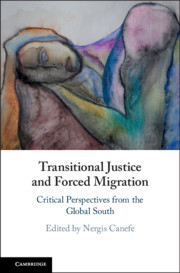Book contents
- Transitional Justice and Forced Migration
- Transitional Justice and Forced Migration
- Copyright page
- Dedication
- Contents
- Contributors
- Preface
- Acknowledgements
- Abbreviations
- In Lieu of an Introduction
- Part I The Past as the Memory of the Future
- 1 Borderlands of Independent India
- 2 A Restorative Justice Approach to the “Armenian Problem”
- 3 Hybrid Courts, Transitional Justice, and Displacement in the Global South
- Part II Law, Justice, and Hope
- Part III Ethics of Witnessing
- Index
- References
3 - Hybrid Courts, Transitional Justice, and Displacement in the Global South
from Part I - The Past as the Memory of the Future
Published online by Cambridge University Press: 24 October 2019
- Transitional Justice and Forced Migration
- Transitional Justice and Forced Migration
- Copyright page
- Dedication
- Contents
- Contributors
- Preface
- Acknowledgements
- Abbreviations
- In Lieu of an Introduction
- Part I The Past as the Memory of the Future
- 1 Borderlands of Independent India
- 2 A Restorative Justice Approach to the “Armenian Problem”
- 3 Hybrid Courts, Transitional Justice, and Displacement in the Global South
- Part II Law, Justice, and Hope
- Part III Ethics of Witnessing
- Index
- References
Summary
Displacement, dispossession and civil war have always been handmaidens. Looking just at South and Southeast Asia, the Philippines and Sri Lanka, Myanmar and Pakistan, Afghanistan, India and neighboring Bangladesh, China, Tibet, and Turkic former Soviet Republics harbor millions of peoples displaced in the last two decades alone. Similarly, between Iraq, Syria, Turkey, Egypt, Israel, Iran, Cyprus, and North African countries, Middle East is now home to more than 10 million displaced peoples, not able to leave the region and shuffled between different war zones. In Europe and Eurasia, at least 2.5 million people remain internally displaced. In the case of Bosnia, Serbia, and Kosovo, and Armenia, Azerbaijan, and Georgia in the South Caucasus, scores have been “displaced” for close to two decades now, and a whole new generation of children are born while being dispossessed. Thus far, hardly any substantive connections have been made between the framework for state criminality defined by international criminal law and the justice and accountability approach, and the exponentially increasing waves of forced migration and displacement.
- Type
- Chapter
- Information
- Transitional Justice and Forced MigrationCritical Perspectives from the Global South, pp. 52 - 80Publisher: Cambridge University PressPrint publication year: 2019

